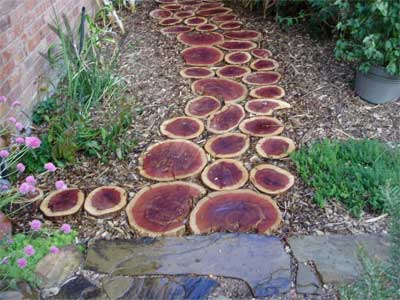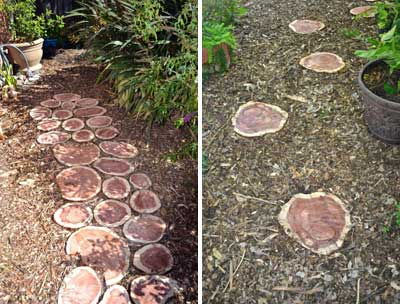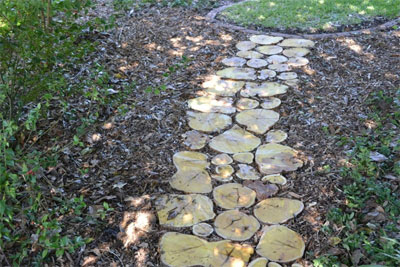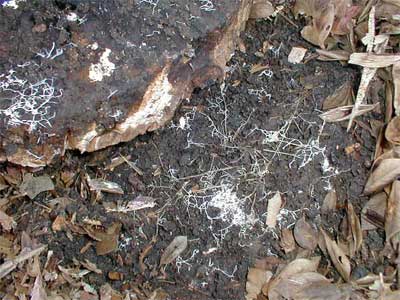Texas Tree Tips – October, 2011

Red cedar cookie walk. Photos by Steve Houser
“Cookie Walks”
A unique way to recycle your tree
Within the forces of nature, from death comes life. As a tree dies in a natural forest condition, it provides many benefits to the ecosystem as it slowly rots, decays, and falls to the forest floor. It is part of an important natural process that helps to sustain an ecological balance in nature.
Have you ever looked under a decaying log lying on the forest floor? You will find it teeming with life — everything from earthworms, reptiles, and insects, to a congregation of small feeder roots from nearby plants. A dead tree offers many important types of life-supporting habitats for both plant and animal kingdoms, including a place to live protected from the elements, or the only place to find moisture during a drought.
If dead trees are an important part of the natural process, how many snags, as they are referred to by arborists, are found in your neighborhood? Although they may be deemed unsightly, they are excellent wildlife habitat and can be left alone if the trees will not damage something (or somebody) should they fall. Mother Nature prefers that we leave dead trees and fallen branches, but it may not be practical in many urban settings.
Letting a dead tree stand does not generate income for an arborist — but contrary to conventional thinking, it is undoubtedly in the best interest of our urban ecology.
Where do dead trees go? If logs are hauled to our local landfill, they ultimately biodegrade, which helps to generate methane gas — an energy source. That’s not a bad deal, but it may not be the best use of the resource. If logs are burned, energy is generated, but the carbon and other materials stored by the tree throughout its life, are released.
Communities experiencing a catastrophic loss of trees from hurricanes, ice storms, or tornadoes have created alternative ways to use dead trees. Remaining tree trunks are carved into artwork. Limbs are chipped into mulch to replenish the soil. In some cases, the trunks are milled and converted to furniture, artwork, or other usable objects. Some wise individuals make exquisite writing pens out of leftover wood to raise funds for worthy causes.
Another option is to use the wood in a way that nature intended by cutting the trunks or larger limbs into “tree cookies.” Tree cookies are thinly crosscut sections of wood — nature’s version of the concrete stepping stone. The cookies can be used to form an informal walkway, using mulch or other materials to hold them in place. It may look odd at first glance, but consider that downtown Dallas streets were once paved with thick tree cookies made from bois d`arc trees. Bois d’arc wood is hard and resistant to rot; therefore, it makes a long-lasting paver. Likewise, many old houses were built on bois d`arc piers because our ancestors found a good use for what nature provided.

Red cedar used in a walk and as "stepping cookies."
Tree cookies can be sealed or stained on the top side to help retain the wood grain look. Any sealer on the underside could affect the soil health or plants nearby and is not recommended. As the cookies start to turn grey, they can blend with the landscape colors or they can be resealed from time to time. If they are bois d’arc cookies, the wood becomes harder as it dries and they can last a lifetime. Over time, the cookies will decay. Just pitch them into your compost pile or cover them with mulch near your favorite tree.

Bois d’ arc cookie walk.
Tree cookie walks may be best used in a backyard or in areas with limited foot traffic. They are not ideal for use by those with limited physical abilities.
Some of the benefits of cookie walks include:
• Nearby tree and plant roots congregate under the cookies in search of water and the ideal environment.
• Tree cookies help retain soil moisture and conserve water by reducing irrigation requirements.
• Decaying organic material encourages microbial activity in the soil, which is highly beneficial to nearby trees and plants.
• Once the soil becomes more active, earthworms also appear, further increasing the soil’s fertility.


Root hairs and earthworms show evidence of improved soil health.
Consider planting some tree cookies for future prosperity.
About the author: Steve Houser is a Dallas native with more than 30 years of experience as a consulting arborist and tree climber. He is the president of Arborilogical Services Inc., “The Experts Your Trees Deserve.” www.arborilogical.com.
